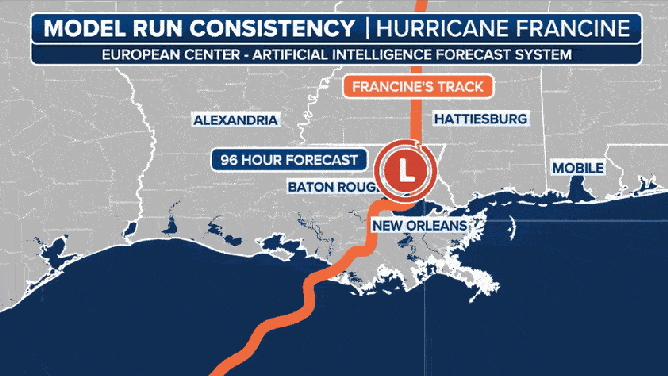How artificial intelligence is storming the world of meteorology
A new machine learning weather model beat traditional models predicting Hurricane Francine.
How artificial intelligence computer models could revolutionize weather forecasting
Hear how a European-made artificial intelligence computer model predicted Hurricane Francine’s development nearly 10 days before the storm lashed the southern Louisiana coast, beating most of the traditional models.
Artificial intelligence is sprouting up as one of the most promising revolutionary technologies in meteorology, and weather-AI experts say it’s just the beginning.
One version of the cutting-edge technology made a remarkable accomplishment this month. A European-made artificial intelligence computer model predicted Hurricane Francine’s development nearly 10 days before the storm lashed the southern Louisiana coast, beating most of the traditional models.
The AI forecast "did a really good job of latching onto Francine quite early," University of Oklahoma professor Amy McGovern told FOX Weather. McGovern runs the A.I. Institute for Research on Trustworthy AI in Weather.
Meteorologists rarely put total confidence into a single model but instead, look at a suite of model forecasts. Most global models compute 10-day outlooks every six hours and one way forecasters gauge a model’s reliability is by checking its consistency from run to run.

Model run consistency for the EC's Artificial Intelligence Forecast System for Hurricane Francine.
The AI model aced this test also. The AI alternative predicted landfall in southern Louisiana every run up until its landfall near Morgan City, LA.
"The consistency is just incredible," said Houston meteorologist Matt Lanza in a post on X, formerly Twitter. "Even the best performing traditional models I don’t believe were this consistent."
Miniscule amount of computer power needed for AI forecasts
The European Center for Medium-Range Weather Forecasts (ECMWF) released the new AI model, called EC-AIFS, earlier this year. They also run a standard global weather forecast model widely accepted as one of the most accurate in the world.
But compared to classic computing technology, AI is "much more computationally efficient," according to McGovern. "The AI models are able to bring in a tremendous amount of historical data and then run this very, very quickly."
AI models are trained on decades of weather data using machine learning. Once trained, they create forecasts in a fraction of the time needed for conventional models and with a miniscule amount of computer power.
AI forecasts have their downsides, however. As of now, AI models use a coarse resolution in their forecasts. Imagine comparing two television screens. A screen from the mid-2000s with fewer pixels will display blurry images while a new 4K flatscreen will show off crisp details due to its higher resolution. For now, AI is using the mid-2000s version.
As a result, AI forecasts are more effective at large scale events, according to McGovern. "They’re looking at the large-scale events like heat waves and tropical cyclones but less at the smaller scale events like tornadoes," she said. "We’re not quite to that yet."
Humans still need to be involved
AI also presents another challenge: trustworthiness. AI outputs rely less on concrete atmospheric physics and more on unique pattern recognition. This means it can be difficult to figure out why the model is doing something particular.
The answer, McGovern says, is that humans still need to be involved in the loop.
"These are just providing a new tool for the human forecasters," she said.
The EC-AIFS is one of several new AI models from tech companies, including Google, NVIDIA, IBM and Microsoft.
The federal government is betting big on AI weather forecasting as well. NOAA announced a $100 million upgrade for a new high performance computer system called Rhea, which uses graphical processing ideal for artificial intelligence and machine learning.
"The coordination between NOAA and those private industries is going to be really critical," McGovern said. "That together is going to create really top forecasts."
